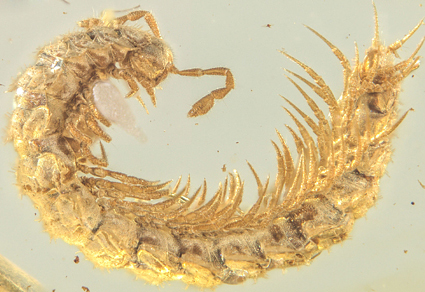Abstract
A new species of the ‘flat-backed’ millipede family Polydesmidae, Propolydesmus cretaceus sp. nov., is described from the mid-Cretaceous Burmese amber. Detailed morphological characters are provided on the basis of 3 well-preserved adults (2 males and 1 females), 2 female subadults, and 14 additional specimens, using confocal laser scanning microscopy (CLSM) and X-ray micro-computed tomography (μCT) with computer-aided 3D-reconstructions. The new species can be placed in the extant genus Propolydesmus. It majorly differs from other congeners due to the stronger gonopod acropodite and the presence of a bipartite gonopod exomerite.
References
- Azar, D., Perrichot, V., Néraudeau, D. & Nel, A. (2003) New psychodid flies from the Cretaceous ambers of Lebanon and France, with a discussion about Eophlebotomus connectens Cockerell, 1920 (Diptera, Psychodidae). Annals of the Entomological Society of America, 96, 117–127. https://doi.org/10.1603/0013-8746(2003)096[0117:NPFTCA]2.0.CO;2
- Cruickshank, R.D. & Ko, K. (2003) Geology of an amber locality in the Hukawng Valley, northern Myanmar. Journal of Asian Earth Sciences, 21, 441–455. https://doi.org/10.1016/S1367-9120(02)00044-5
- Djursvoll, P. (2008) Revision of the Iberian millipede genus Schizomeritus Verhoeff, 1931 (Diplopoda: Polydesmidae), with the description of three new species. International Journal of Myriapodology, 1 (1), 111–122. https://doi.org/10.1163/187525408X316776
- Djursvoll, P., Golovatch, S.I., Johanson, K.A. & Meidell, B. (2000) Phylogenetic relationships within Polydesmus sensu lato (Diplopoda: Polydesmidae). Fragmenta Faunistica, 43 (Supplement), 37–57.
- Enghoff, H. & Golovatch, S.I. (2003) The millipede genus Propolydesmus Verhoeff, 1895 redefined, with a revision of the genus in the Canary Islands (Diplopoda, Polydesmida, Polydesmidae). Graellsia, 59 (1), 79–86. https://doi.org/10.3989/graellsia.2003.v59.i1.225
- Enghoff, H., Golovatch, S.I., Short, M., Stoev, O. & Wesener, T. (2015) Diplopoda—taxonomic overview. In: Minelli, A. (Ed.), Treatise on Zoology—Anatomy, taxonomy, biology. The Myriapoda. Volume 2. Brill, Leiden and Boston, pp. 363–453. https://doi.org/10.1163/9789004188273_017
- Fernández, R., Edgecombe, G.D. & Giribet, G. (2016) Exploring phylogenetic relationships within Myriapoda and the effects of matrix composition and occupancy on phylogenomic reconstruction. Systematic Biology, 65, 871–889.
- Fu, Y.Z., Li, Y.D., Su, Y.T., Cai, C.Y. & Huang, D.Y. (2021) Application of confocal laser scanning microscopy to the study of amber bioinclusions. Palaeoentomology, 4 (3), 266–278. https://doi.org/10.11646/palaeoentomology.4.3.14
- Grimaldi, D.A., Engel, M.S. & Nascimbene, P.C. (2002) Fossiliferous Cretaceous amber from Myanmar (Burma): its rediscovery, biotic diversity, and paleontological significance. American Museum Novitates, 3361, 1–71. https://doi.org/10.1206/0003-0082(2002)361%3C0001:FCAFMB%3E2.0.CO;2
- Hoffman, R. (1969) Myriapoda, exclusive of Insecta. In: Moore, R. (Ed.), Treatise on Invertebrate Paleontology. Part R. Vol. 2. Geological Society of America and University of Kansas Press, Lawrence, Kansas, pp. 572–606.
- Jiang, X.K., Shear, W.A., Hennen, D.A., Chen, H.M. & Xie, Z.C. (2019) One hundred million years of stasis: Siphonophora hui sp. nov. the first Mesozoic sucking millipede (Diplopoda: Siphonophorida) from mid-Cretaceous Burmese amber. Cretaceous Research, 97, 34–39. https://doi.org/10.1016/j.cretres.2019.01.011
- Mao, Y.Y., Liang, K., Su, Y.T., Li, J.G., Rao, X., Zhang, H., Xia, F.Y., Fu, Y.Z., Cai, C.Y. & Huang, D.Y. (2018) Various amberground marine animals on Burmese amber with discussions on its age. Palaeoentomology, 1 (1), 91–103. https://doi.org/10.11646/palaeoentomology.1.1.11
- Ross, A.J. (2019) Burmese (Myanmar) amber checklist and bibliography 2018. Palaeoentomology, 2 (1), 22–84. https://doi.org/10.11646/palaeoentomology.2.1.5
- Ross, A.J. (2021) Supplement to the Burmese (Myanmar) amber checklist and bibliography, 2020. Palaeoentomology, 4 (1), 57–76. https://doi.org/10.11646/palaeoentomology.4.1.11
- Ross, A.J. (2023) Supplement to the Burmese (Myanmar) amber checklist and bibliography, 2022. Palaeoentomology, 6 (1), 22–40. https://doi.org/10.11646/palaeoentomology.6.1.6
- Ross, A.J., Mellish, C., York, P. & Crighton, B. (2010) Burmese amber. In: Penney, D. (Ed.), Biodiversity of fossils in amber from the major world deposits. Siri Scientific Press, Manchester, pp. 208–235.
- Shi, G.H., Grimaldi, D.A., Harlow, G.E., Wang, J., Wang, J., Yang, M.C., Lei, W.Y., Li, Q.L. & Li, X.H. (2012) Age constraint on Burmese amber based on U-Pb dating of zircons. Cretaceous Research, 37, 155–163. https://doi.org/10.1016/j.cretres.2012.03.014
- Sierwald, P. & Spelda, J. (2023) MilliBase. Propolydesmus Verhoeff, 1895. Available from: https://millibase.org/aphia.php?p=taxdetails&id=892409 (accessed 28 November 2023)
- Su, Y.T., Cai, C.Y. & Huang, D.Y. (2021) Morphological revision of Siphonophora hui (Myriapoda: Diplopoda: Siphonophoridae) from the mid-Cretaceous Burmese amber. Palaeoentomology, 4 (3), 279–288. https://doi.org/10.11646/palaeoentomology.4.3.15
- Su, Y.T., Cai, C.Y. & Huang, D.Y. (2022) A new species of Trichopolydesmidae (Myriapoda, Diplopoda, Polydesmida) from the mid-Cretaceous Burmese amber. Palaeoentomology, 5 (6), 606–622.
- https://doi.org/10.11646/palaeoentomology.5.6.10
- Wesener, T. & Moritz, L. (2018) Checklist of the Myriapoda in Cretaceous Burmese amber and a correction of the Myriapoda identified by Zhang (2017). Check List, 14 (6), 1131–1140. https://doi.org/10.15560/14.6.1131
- Zherikhin, V.V. & Ross, A.J. (2000) A review of the history, geology and age of Burmese amber (Burmite). Bulletin of the Natural History Museum, London, Geology, 56, 3–10.


